Ryan Moffett woke up and could not feel his toes. They felt numb and had a tingly sensation. The next day, he woke up and felt a definite numbness all the way up to his belly button.
Moffett — with a wife and four daughters — was diagnosed with multiple sclerosis at 42.
Disease, death, loneliness and depression are part of human nature and life. The Pro Tempore exhibit in the Harold B. Lee Library explores these human emotions and mortal experiences. Moffett is one of the three artists whose art pieces make up the exhibit.
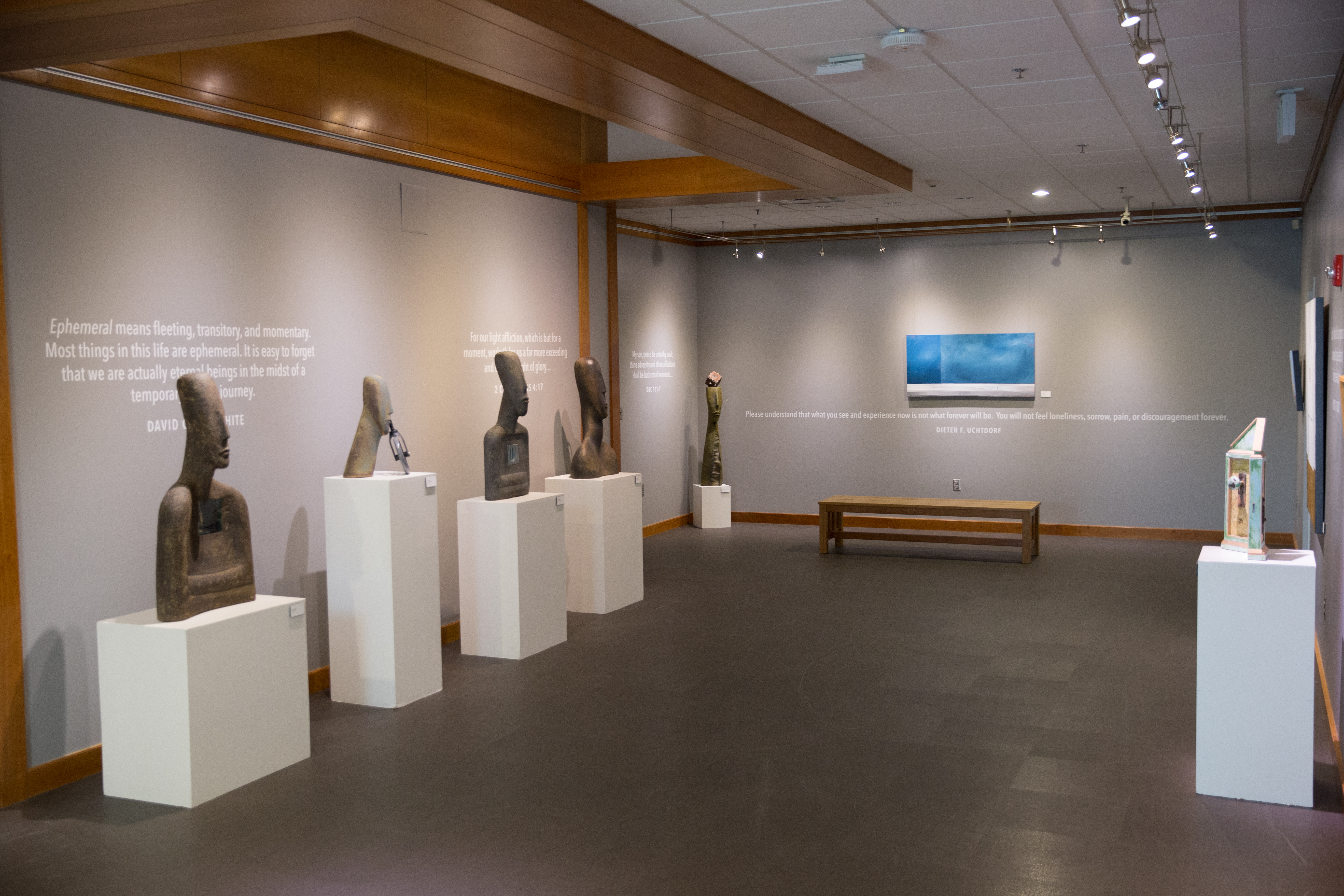
“I think that with my experience with MS, I’ve been in a really dark place. I’ve experienced loss with not being able to do things that I used to be able to do and the fear of losing control of my body,” Moffett said. “I think the exhibit deals with that loss and also how we can receive peace and comfort. I think my pieces deal directly with that.”
Pro Tempore is a Latin phrase meaning “for the time being.” The exhibit’s main aim is to be a space where visitors can validate their emotions but ultimately find hope in the knowledge that the gospel of Jesus Christ brings and recognize the temporary nature of this life.
Jason Lanegan and Justin Wheatley are the other two local artists whose artwork is displayed in the exhibit.
“It’s supposed to make you feel that sense of separation and maybe even loneliness,” exhibit curator Melanie Allred said.
In the exhibit, Moffett’s sculptures focus on isolation between the body and the brain, which he relates to because of his MS. Lanegan’s mixed media pieces focus on separation between other people, primarily with death. Wheatley’s paintings have an element of isolation in place.
Inspirational Latter-day Saint quotes are mixed throughout the exhibit.
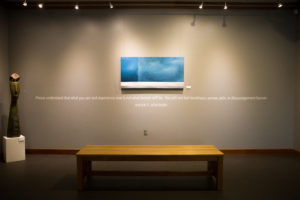
“What I want that exhibit to be is it’s okay to be sad and to just know that it will be temporary. That it will end, whatever it is. It may end quickly. It may end when you die, but, overall, all things come to an end,” Allred said.
Moffett’s art pieces in the exhibit are influenced directly by his diagnosis. He has multiple sculptures that are ancient-looking Cycladic art heads in the exhibit.
“It’s just moving. When you look at those pieces, there’s a few of them that just absolutely freeze me in my steps,” Lanegan said, commenting on Moffett’s sculptures.
Many of the heads have damaged electrical cords coming out of them, representing the disconnect he feels between his brain and his body.
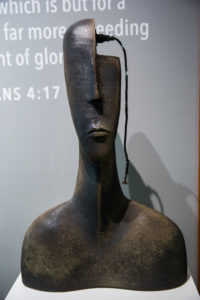
“A lot of the imagery that I am using right now came from my first meeting with my doctor when he explained what MS was,” Moffett said. “That’s why you see electrical cords that are frayed and damaged. That represents the nerves in my body that are frayed and damaged.”
Visual Arts Librarian Christiane Ramsey said Moffett once explained to her the reason for one of the sculptures named “Dizzy in a Wheelchair” in the exhibit.
“There is one where there’s a head resting on a wheel. And he said, ‘Yeah, this is going to be me because I’m going to be part of a wheelchair.’ So the exhibit is very powerful in terms of the imagery, not just the objects themselves,” Ramsey said.
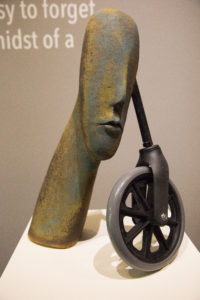
Through knowledge, both temporal and spiritual, Moffett said he has found peace.
“The peace comes to your soul — to your heart. Right now, my thought is I could end up in a wheelchair. I could be completely debilitated and lose my job, but I’ll still have the knowledge that there’s a greater plan. That’s why I have peace,” Moffett said.
Lanegan said his mixed media pieces are also inspired from personal experiences. One piece called “Holding Ground” is a blue house with a large rock suspended underneath it.
The home in the exhibit is the exact model of the house he lived in when the missionaries taught him about the gospel, and the stone underneath represents the idea of holding ground.

“It’s trying to find a foundation to build on while the world is still trying to erode it as you’re grasping for it. It’s about the turmoil of going through that,” Lanegan said.
A painting that is a central element in the exhibit is called “The Man and the Horizon.” The painting portrays a tiny human figure standing in a large expanse. Wheatley’s inspiration for the painting was Moroni in the Book of Mormon when he was seemingly alone.
Wheatley described how Moroni wasn’t really alone because he had God at his side. He just had to wait the experience out.
“To me, it’s a hopeful painting. It’s really about the fact that you’re not alone,” Wheatley said.
Allred said she hopes BYU students and viewers can visit the exhibit and acknowledge their isolating experiences.
“I think sometimes, especially here at BYU and in our LDS culture, we expect ourselves to always be perfect and have everything together. I wanted this to be a space where people could take a deep breath and say, ‘I am isolated! I am depressed! I am struggling with some really hard things,’” Allred said.
However, Allred said she does not want viewers to stay in that state of mind but rather allow the validation of those feelings to begin the process of finding hope.
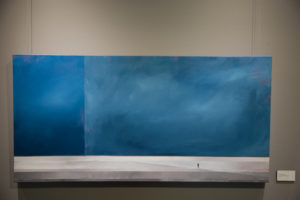
“The hope is that you go in and you feel this big sense of validation, and — without platitudes — recognize that it will be temporary,” Allred said.
The exhibit is located on the first floor of the HBLL in the Auditorium Gallery. It will be on display until Sept. 28.
“I think a lot of times, people may think that art is there to answer questions, to give you an explanation of something, but I really feel that it’s the other way around. It should be something that makes you think and makes you ask questions,” Ramsey said.




